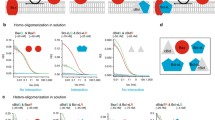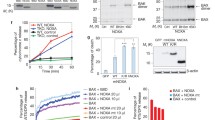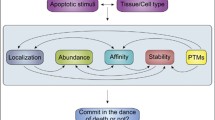Abstract
The stoichiometry and affinity of Bcl-2 family complexes are essential information for understanding how their interactome network is orchestrated to regulate mitochondrial permeabilization and apoptosis. Based on over-expression model system, FRET analysis was used to quantify the protein–protein interactions among Bax, Bcl-xL, Bad and tBid in healthy and apoptotic cells. Our data indicate that the stoichiometry and affinity of Bcl-2 complexes are dependent on their membrane environment. Bcl-xL, Bad and tBid can form hetero-trimers in mitochondria. Bcl-xL binds preferentially to Bad, then to tBid and Bax in mitochondria, whilst Bcl-xL displays higher affinity to Bad or tBid than to itself. Strikingly, Bax can bind to Bcl-xL in cytosol. In cytosol of apoptotic cells, Bcl-xL associates with Bax to form hetero-trimer with 1:2 stoichiometry, while Bcl-xL associates with Bad to form hetero-trimer with 2:1 stoichiometry and Bcl-xL associates with tBid to form hetero-dimer. In mitochondria, Bcl-xL associates with Bax/Bad to form hetero-dimer in healthy cells, while Bcl-xL associates with Bad to form hetero-tetramer with 3:1 stoichiometry in apoptotic cells.









Similar content being viewed by others
Abbreviations
- FRET:
-
Fluorescence resonance energy transfer
- BH:
-
Bcl-2 homology domains
- Bax:
-
Bcl-2-associated X protein
- Bak:
-
Bcl-2 antagonist killer
- MOM:
-
Mitochondrial outer membrane
- Bcl-2:
-
B-cell lymphoma 2
- Bcl-xL:
-
B-cell lymphoma, long isoform
- Bcl-w:
-
Bcl2L2, Bcl-2-like protein 2
- A1:
-
Bcl-2-related protein A1
- Mcl-1:
-
Myeloid cell leukemia sequence 1
- BH3:
-
Bcl-2 homology 3
- Bid:
-
BH3-interacting domain death agonist
- tBid:
-
Truncated Bid protein
- Bim:
-
Bcl-2-protein 11
- Puma:
-
p53 upregulated modulator of apoptosis
- Bad:
-
Bcl-2 antagonist of cell death
- Noxa:
-
PMAIP1, Phorbol-12-myristate-13-acetate-induced protein 1
- FCCS:
-
Fluorescence cross-correlation spectroscopy
- DMEM:
-
Dulbecco’s modified Eagle’s medium
- FBS:
-
Fetal bovine serum
- STS:
-
Staurosporine
- DiIC1:
-
1,1′,3,3,3′,3′-Hexamethylin-dodicarbocyanine iodide
- PbFRET:
-
Partial acceptor photobleaching-based FRET
- ROIs:
-
Regions of interest
References
Youle RJ, Strasser A (2008) The BCL-2 protein family: opposing activities that mediate cell death. Nat Rev Mol Cell Biol 9:47–59
Garcia-Saez AJ (2012) The secrets of the Bcl-2 family. Cell Death Differ 19:1733–1740
Pena-Blanco A, Garcia-Saez AJ (2018) Bax, Bak and beyond—mitochondrial performance in apoptosis. FEBS J 285:416–431
Ku B, Liang C, Jung JU, Oh B-H (2011) Evidence that inhibition of BAX activation by BCL-2 involves its tight and preferential interaction with the BH3 domain of BAX. Cell Res 21:627–641
Cartron PF, Gallenne T, Bougras G, Gautier F, Manero F, Vusio P, Meflah K, Vallette FM, Juin P (2004) The first alpha helix of Bax plays a necessary role in its ligand-induced activation by the BH3-only proteins bid and PUMA. Mol Cell 16:807–818
Billen LP, Shamas-Din A, Andrews DW (2008) Bid: a Bax-like BH3 protein. Oncogene 27:S93–S104
Merino D, Giam M, Hughes PD, Siggs OM, Heger K, O’Reilly LA, Adams JM, Strasser A, Lee EF, Fairlie WD, Bouillet P (2009) The role of BH3-only protein Bim extends beyond inhibiting Bcl-2-like prosurvival proteins. J Cell Biol 186:355–362
Chipuk JE, Moldoveanu T, Llambi F, Parsons MJ, Green DR (2010) The BCL-2 family reunion. Mol Cell 37:299–310
Yan J, Zhang H, Xiang J, Zhao Y, Yuan X, Sun B, Lin A (2018) The BH3-only protein BAD mediates TNFα cytotoxicity despite concurrent activation of IKK and NF-κB in septic shock. Cell Res 28:701–718
Hsu YT, Wolter KG, Youle RJ (1997) Cytosol-to-membrane redistribution of Bax and Bcl-X(L) during apoptosis. Proc Natl Acad Sci USA 94:3668–3672
Hausmann G, O’Reilly LA, van Driel R, Beaumont JC, Strasser A, Adams JM, Huang DC (2000) Pro-apoptotic apoptosis protease-activating factor 1 (Apaf-1) has a cytoplasmic localization distinct from Bcl-2 or Bcl-x(L). J Cell Biol 149:623–634
Jeong SY, Gaume B, Lee YJ, Hsu YT, Ryu SW, Yoon SH, Youle RJ (2004) Bcl-x(L) sequesters its C-terminal membrane anchor in soluble, cytosolic homodimers. EMBO J 23:2146–2155
Bleicken S, Hantusch A, Das KK, Frickey T, Garcia-Saez AJ (2017) Quantitative interactome of a membrane Bcl-2 network identifies a hierarchy of complexes for apoptosis regulation. Nat Commun 8:73
Edlich F, Banerjee S, Suzuki M, Cleland MM, Arnoult D, Wang C, Neutzner A, Tjandra N, Youle RJ (2011) Bcl-x(L) retrotranslocates Bax from the mitochondria into the cytosol. Cell 145:104–116
Schellenberg B, Wang P, Keeble JA, Rodriguez-Enriquez R, Walker S, Owens TW, Foster F, Tanianis-Hughes J, Brennan K, Streuli CH, Gilmore AP (2013) Bax exists in a dynamic equilibrium between the cytosol and mitochondria to control apoptotic priming. Mol Cell 49:959–971
Aranovich A, Liu Q, Collins T, Geng F, Dixit S, Leber B, Andrews DW (2012) Differences in the mechanisms of proapoptotic BH3 proteins binding to Bcl-XL and Bcl-2 quantified in Live MCF-7 cells. Mol Cell 45:754–763
Du MY, Yang FF, Mai ZH, Qu WF, Lin FR, Wei LC, Chen TS (2018) FRET two-hybrid assay by linearly fitting FRET efficiency to concentration ratio between acceptor and donor. Appl Phys Lett 112:153702
Li HL, Zhu H, Xu CJ, Yuan JY (1998) Cleavage of BID by caspase 8 mediates the mitochondrial damage in the Fas pathway of apoptosis. Cell 94:491–501
Chou JJ, Li HL, Salvesen GS, Yuan JY, Wagner G (1999) Solution structure of BID, an intracellular amplifier of apoptotic signaling. Cell 96:615–624
Eskes R, Desagher S, Antonsson B, Martinou JC (2000) Bid induces the oligomerization and insertion of Bax into the outer mitochondrial membrane. Mol Cell Biol 20:929–935
Lovell JF, Billen LP, Bindner S, Shamas-Din A, Fradin C, Leber B, Andrews DW (2008) Membrane binding by tBid initiates an ordered series of events culminating in membrane permeabilization by Bax. Cell 135:1074–1084
Billen LP, Kokoski CL, Lovell JF, Leber B, Andrews DW (2008) Bcl-XL inhibits membrane permeabilization by competing with Bax. PLoS Biol 6:e147
Llambi F, Moldoveanu T, Tait SWG, Bouchier-Hayes L, Temirov J, McCormick LL, Dillon CP, Green DR (2011) A unified model of mammalian BCL-2 protein family interactions at the mitochondria. Mol Cell 44:517–531
Selvin PR (1995) Fluorescence resonance energy transfer. Method Enzymol 246:300–334
Dussmann H, Rehm M, Concannon CG, Anguissola S, Wurstle M, Kacmar S, Voller P, Huber HJ, Prehn JHM (2010) Single-cell quantification of Bax activation and mathematical modelling suggest pore formation on minimal mitochondrial Bax accumulation. Cell Death Differ 17:278–290
Placone J, Hristova K (2012) Direct assessment of the effect of the Gly380Arg achondroplasia mutation on FGFR3 dimerization using quantitative imaging FRET. PLoS One 7:e46678
Erickson MG, Liang HY, Mori MX, Yue DT (2003) FRET two-hybrid mapping reveals function and location of L-type Ca2+ channel CaM preassociation. Neuron 39:97–107
Ben-Johny M, Yue DN, Yue DT (2016) Detecting stoichiometry of macromolecular complexes in live cells using FRET. Nat Commun 7:13709
Valentijn AJ, Metcalfe AD, Kott J, Streuli CH, Gilmore AP (2003) Spatial and temporal changes in Bax subcellular localization during anoikis. J Cell Biol 162:599–612
Butz ES, Ben-Johny M, Shen M, Yang PS, Sang LJ, Biel M, Yue DT, Wahl-Schott C (2016) Quantifying macromolecular interactions in living cells using FRET two-hybrid assays. Nat Protoc 11:2470–2498
Zhang J, Zhang LL, Chai LY, Yang FF, Du MY, Chen TS (2016) Reliable measurement of the FRET sensitized-quenching transition factor for FRET quantification in living cells. Micron 88:7–15
Elder AD, Domin A, Schierle GSK, Lindon C, Pines J, Esposito A, Kaminski CF (2009) A quantitative protocol for dynamic measurements of protein interactions by Forster resonance energy transfer-sensitized fluorescence emission. J R Soc Interface 6:S59–S81
Yu HN, Zhang JW, Li HL, Qu JL, Chen TS (2012) An empirical quantitative fluorescence resonance energy transfer method for multiple acceptors based on partial acceptor photobleaching. Appl Phys Lett 100:253701
Erickson MG, Alseikhan BA, Peterson BZ, Yue DT (2001) Preassociation of calmodulin with voltage-gated Ca2+ channels revealed by FRET in single living cells. Neuron 31:973–985
Hoppe A, Christensen K, Swanson JA (2002) Fluorescence resonance energy transfer-based stoichiometry in living cells. Biophys J 83:3652–3664
Zal T, Gascoigne NRJ (2004) Photobleaching-corrected FRET efficiency imaging of live cells. Biophys J 86:3923–3939
Chen H, Puhl HL, Koushik SV, Vogel SS, Ikeda SR (2006) Measurement of FRET efficiency and ratio of donor to acceptor concentration in living cells. Biophys J 91:L39–L41
Zhu W, Cowie A, Wasfy GW, Penn LZ, Leber B, Andrews DW (1996) Bcl-2 mutants with restricted subcellular location reveal spatially distinct pathways for apoptosis in different cell types. EMBO J 15:4130–4141
Chin HS, Li MX, Tan IKL, Ninnis RL, Reljic B, Scicluna K, Dagley LF, Sandow JJ, Kelly GL, Samson AL, Chappaz S, Khaw SL, Chang C, Morokoff A, Brinkmann K, Webb A, Hockings C, Hall CM, Kueh AJ, Ryan MT, Kluck RM, Bouillet P, Herold MJ, Gray DHD, Huang DCS, Van DMF, Dewson G (2018) VDAC2 enables Bax to mediate apoptosis and limit tumor development. Nat Commun 9:4976
Rehm M, Huber HJ, Hellwig CT, Anguissola S, Dussmann H, Prehn JH (2009) Dynamics of outer mitochondrial membrane permeabilization during apoptosis. Cell Death Differ 16:613–623
Grinberg M, Sarig R, Zaltsman Y, Frumkin D, Grammatikakis N, Reuveny E, Gross A (2002) tBID homooligomerizes in the mitochondrial membrane to induce apoptosis. J Biol Chem 277:12237–12245
Szymczak AL, Workman CJ, Wang Y, Vignali KM, Dilioglou S, Vanin EF, Vignali DAA (2004) Correction of multi-gene deficiency in vivo using a single ‘self-cleaving’ 2A peptide-based retroviral vector. Nat Biotechnol 22:589–594
Lopez J, Bessou M, Riley JS, Giampazolias E, Todt F, Rochegue T, Oberst A, Green DR, Edlich F, Ichim G, Tait SWG (2016) Mito-priming as a method to engineer Bcl-2 addiction. Nat Commun 7:10538
Bhola PD, Letai A (2016) Mitochondria-Judges and executioners of cell death sentences. Mol Cell 61:695–704
Letai A, Bassik MC, Walensky L, Sorcinelli MD, Weiler S, Korsmeyer SJ (2002) Distinct BH3 domains either sensitize or activate mitochondrial apoptosis serving as prototype cancer therapeutics. Cancer Cell 2:183–192
Wang K, Yin XM, Chao DT, Milliman CL, Korsmeyer SJ (1996) BID: a novel BH3 domain-only death agonist. Gene Dev 10:2859–2869
Wang Y, Tjandra N (2013) Structural insights of tBid, the caspase-8-activated Bid, and its BH3 domain. J Biol Chem 288:35840–35851
Leber B, Lin JL, Andrews DW (2007) Embedded together: the life and death consequences of interaction of the Bcl-2 family with membranes. Apoptosis 12:897–911
Hsu YT, Youle RJ (1998) Bax in murine thymus is a soluble monomeric protein that displays differential detergent-induced conformations. J Biol Chem 273:10777–10783
Ding JZ, Mooers BHM, Zhang Z, Kale J, Falcone D, McNichol J, Huang B, Zhang XJC, Xing CG, Andrews DW, Lin JL (2014) After embedding in membranes antiapoptotic Bcl-XL protein binds both Bcl-2 homology region 3 and helix 1 of proapoptotic Bax protein to inhibit apoptotic mitochondrial permeabilization. J Biol Chem 289:11873–11896
Suzuki M, Youle RJ, Tjandra N (2000) Structure of Bax: coregulation of dimer formation and intracellular localization. Cell 103:645–654
Annis MG, Soucie EL, Dlugosz PJ, Cruz-Aguado JA, Penn LZ, Leber B, Andrews DW (2005) Bax forms multispanning monomers that oligomerize to permeabilize membranes during apoptosis. EMBO J 24:2096–2103
Zhang Z, Subramaniam S, Kale J, Liao C, Huang B, Brahmbhatt H, Condon SGF, Lapolla SM, Hays FA, Ding JZ, He F, Zhang XJC, Li JN, Senes A, Andrews DW, Lin JL (2016) BH3-in-groove dimerization initiates and helix 9 dimerization expands Bax pore assembly in membranes. EMBO J 35:208–236
Puthalakath H, Strasser A (2002) Keeping killers on a tight leash: transcriptional and post-translational control of the pro-apoptotic activity of BH3-only proteins. Cell Death Differ 9:505–512
Kuwana T, Mackey MR, Perkins G, Ellisman MH, Latterich M, Schneiter R, Green DR, Newmeyer DD (2002) Bid, Bax, and lipids cooperate to form supramolecular openings in the outer mitochondrial membrane. Cell 111:331–342
Adams JM, Cory S (2018) The BCL-2 arbiters of apoptosis and their growing role as cancer targets. Cell Death Differ 25:27–36
Acknowledgements
We thank David W. Andrews for providing mCherry-Bad and mCherry-tBid plasmids and Andrew P. Gilmore for providing CFP-Bax plasmid. This work was supported by grants from the National Natural Science Foundation of China (NSFC), (Grant Nos. 61527825, 61875056 and 81572184).
Author information
Authors and Affiliations
Contributions
FY designed and performed experiments, analyzed data, and wrote the manuscript. WQ, MD, ZM, BW, and YM performed experiments. XW and TC designed the study, planned experiments, and wrote the manuscript.
Corresponding authors
Ethics declarations
Conflict of interest
The authors declare that they have no conflict of interest.
Additional information
Publisher's Note
Springer Nature remains neutral with regard to jurisdictional claims in published maps and institutional affiliations.
Electronic supplementary material
Below is the link to the electronic supplementary material.
Rights and permissions
About this article
Cite this article
Yang, F., Qu, W., Du, M. et al. Stoichiometry and regulation network of Bcl-2 family complexes quantified by live-cell FRET assay. Cell. Mol. Life Sci. 77, 2387–2406 (2020). https://doi.org/10.1007/s00018-019-03286-z
Received:
Revised:
Accepted:
Published:
Issue Date:
DOI: https://doi.org/10.1007/s00018-019-03286-z




